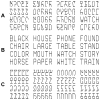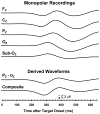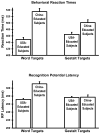Effects of long-time reading experience on reaction time and the recognition potential
- PMID: 20307598
- PMCID: PMC2866801
- DOI: 10.1016/j.ijpsycho.2010.03.006
Effects of long-time reading experience on reaction time and the recognition potential
Abstract
The proposition that long-time experience in reading a language gradually builds up rapidly acting neural processes that facilitate the processing of words in that language and speed them into conscious awareness was examined. Behavioral reaction time (RT) and electrophysiological responsiveness to visually displayed words and non-language images were measured in persons who differed in how much experience they had in reading English. The electrophysiological response was the recognition potential (RP). Behavioral RT and the latency of the RP to English words were both expected to depend upon how much English reading experience a person had. The short latency of the RP was expected to free it from the influence of non-perceptual factors that affect RT, such as speed/accuracy tradeoff. This expectation yielded the prediction that the behavioral and electrophysiological results would differ in a specific way. Long-time readers of English were expected to show shorter RP latency to English words than less experienced (China-educated) readers of English but no RP latency difference for non-language images, with which neither group had greater experience. In contrast, due to speed accuracy tradeoff, the China-educated subjects were expected to show longer RT for both the words and the non-language images. The prediction was confirmed. The amount of language experience that a person had showed a stronger relationship to RP latency than it did to RT. This helped to validate the use of the RP as a tool for investigating perception and demonstrated definite advantages that it has for studying acquired perceptual processes in humans.
Copyright 2010 Elsevier B.V. All rights reserved.
Figures






References
-
- Amassian VE, Cracco RQ, Maccabee PJ, Cracco JB, Rudell AP, Eberle LP. Suppression of visual perception by magnetic coil stimulation of human occipital cortex. Electroencephalography and Clinical Neurophysiology. 1989;74:458–462. - PubMed
-
- Dell’Acqua R, Pesciarelli F, Jolicour P, Eimer M, Peressotti F. The interdependence of spatial attention and lexical access as revealed by early asymmetries in occipito-parietal ERP activity. Psychophysiology. 2007;44:436–443. - PubMed
-
- Donders FC. On the speed of mental processes. In: Koster WG, editor. Acta Psychologica 30 Attention and Performance II. 1868/1969. pp. 412–431. - PubMed
-
- Eimer M. The N2pc component as an indicator of attentional selectivity. Electroencephalography and Clinical Neurophysiology. 1996;99:225–234. - PubMed
Publication types
MeSH terms
Grants and funding
LinkOut - more resources
Full Text Sources

